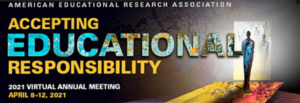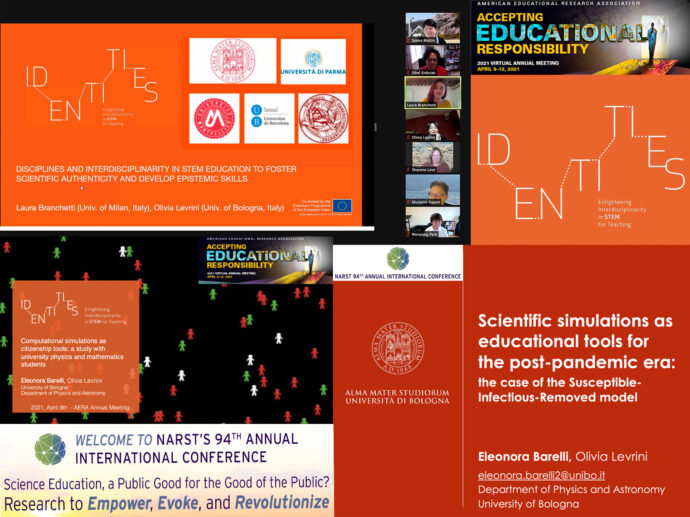The IDENTITIES project has been presented during two prestigious international events in the second week of April 2021, the NARST and AERA Conferences.

The first was the 2021 annual international conference of the National Association of Research in Science Teaching (NARST), based in Orlando, Florida but organized online due to pandemic. At the conference, dr. Laura Branchetti presented the project during the invited symposium organized by the European Science Education Research Association (ESERA). Slides can be accessed clicking here. The session was titled “Crossing Boundaries: Examining and Problematizing Interdisciplinarity in Science Education” and hosted the contributions of Laura Branchetti (University of Milan, Italy), Olivia Levrini (University of Bologna, Italy), Shulamit Kapon (Technion – Israel Institute of Technology), Maayan Schvartzer (Technion – Israel Institute of Technology), Tal Peer (Acheret Center, Israel), Wonyong Park (University of Oxford, UK), Jen-Yi Wu (Department of Life Science, National Taiwan Normal University), Sharona T Levy (University of Haifa), Asnat R. Zoharm (University of Haifa), Ilana Dubovi (Ben-Gurion University, Israel). The president of ESERA, Sibel Erduran (University of Oxford, UK), was the session’s discussant.
Session’s abstract
The session includes four papers focusing on interdisciplinarity in science education. Recent visions of science education call for creating explicit connections between STEM disciplines in science education. Examples include calls for integrating engineering into the instruction of scientific disciplines, engaging students in mathematical and computational modeling as an integral part of their science learning, and engaging students in scientific inquiry contextualized in real-life problems that inherently require the integration of STEM disciplines while demonstrating the relevance and power of science. Students are expected to engage in various STEM practices in these interventions while developing a deep understanding of core scientific practices and ideas. The integration of STEM disciplines while teaching a specific discipline is far from straightforward. The appropriation of knowledge and procedures from one discipline into another often results in epistemological changes in the appropriated constructs. This symposium aims to examine and problematize the potential, challenges, and price that such boundary crossings entail. The four presentations examine these issues from different perspectives, harnessing diverse methodological approaches to focus on the different facets of the conundrum of interdisciplinarity in science education.
At NARST Conference, also Eleonora Barelli (University of Bologna, Italy) presented a paper related to IDENTITIES in the Model-Based Teaching and Learning session. The title of the talk, co-authored by Olivia Levrini, was: “Scientific Simulations as Educational Tools for the Post-Pandemic Era: the Case of the Susceptible-Infectious-Removed Model”. Slides can be downloaded here.
Paper’s abstract
During the COVID-19 pandemic, the whole society with its stakeholders has been exposed to models and computational simulations. Indeed, these scientific tools, usually addressed to experts, were embedded in societal debates and used as a basis for making decisions and evaluating the effects of different measures of social distances to “flatten the curve”. In this paper, we propose an educational analysis of one of the most popular models for the spread of diseases, that has been applied also to the case of COVID-19: the Susceptible-Infectious-Removed (SIR) model. In particular, we mention two main approaches to simulate the SIR model, namely the agent-based and equation-based ones. We argue that simulations are a very interesting case to show in teaching the change in the scientific paradigm from the Newtonian and deterministic view of science to the contemporary one based on probability, agency and emergence. The analysis aims to argue how simulations can implement, in teaching, principles of the OECD recommendations and equip secondary students with knowledge and skills to navigate this uncertain, complex and fast-changing society.

The second conference that hosted IDENTITIES in its program was the 2021 annual meeting of AERA (American Educational Research Association). It was based in Orlando, Florida, too but moved online. At the conference, Eleonora Barelli (University of Bologna) participated in the Science Education in Computer-Supported Collaborative Settings roundtable, with a paper called: “Computational Simulations as Citizenship Tools: A Study With University Physics and Mathematics Students”. Slides can be accessed here.
Paper’s abstract
Computational simulations are scientific tools that have gone beyond professional realms, reaching also non-expert stakeholders. Even if their results are often disseminated via social media, simulations are refined objects whose interpretation and applications require specific knowledge and competences. In this paper we present a study conducted with university Physics and Mathematics students about agent-based simulations developed to support policymakers in decision-making on a complex problem: the formation of terrorist groups. During a role-playing activity, students were asked to discuss different elements of the simulation (statement, graph, scenarios, model) and propose solutions. The analysis shows which forms of reasoning students put into play when faced with a complex societal problem, and how they are triggered by scientific information available.

